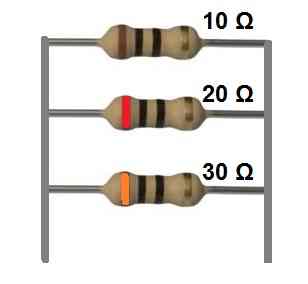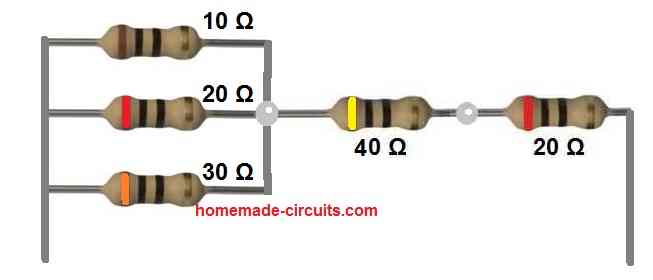There are three ways to interconnect resistors: series, parallel and in combination of series/parallel. When resistors are joined in series, the current passing via one resistor also passes through the next. When resistors are joined in parallel, they are wired across each other, resulting in the same voltage across each resistor. When resistors are connected in a combination of series and parallel, the current passage is a bit more complex.
Connecting Resistors in Series:

Assume you have three resistors with resistances of 10, 20, and 30 ohms. For a series connection:
We connect the 3 resistors one after the other as shown in the above figure.
The total series resistance can be measure across the ends of the series connection using a Ohm meter or can be calculated as I have explained below.
According to Ohm's law the total resistance of the series resistors can be calculated simply by adding the three resistor values.
R(total) = 10 + 20 + 30 = 60 ohms is the total resistance of the circuit.
Connecting Resistors in Parallel:

Let's say you have three resistors with values of 10 ohms, 20 ohms, and 30 ohms. In order to connect them in parallel, you will need to follow the below shown steps:
Connect all left side ends together, and then connect all the right side ends together, as shown in the above figure.
You can measure the parallel resistance value using an Ohm meter by connecting the ends of the resistances with the meter probe.
Alternatively, using the standard formula, the total resistance of the parallel circuit could be calculated as the reciprocal of the sum of the reciprocals of the individual resistances:
1/Rp(total) = 1/10 + 1/20 + 1/30 = 5.45 ohms.
Combination of Series and Parallel:

Now, let's assume we have four resistors with values of 10 ohms, 20 ohms, 30 ohms, and 40 ohms. To connect them in a combination of series and parallel we do the following setup
First we connect 3 resistors in parallel, meaning we connect the 10 ohm, 20 ohm and 30 ohm in parallel.
Then we connect a 40 ohm and a 20 ohm resistor in series and join this series connection with the above parallel setup.
To solve this series, parallel combination, we first solve the parallel configuration using the following formula:
1/Rp(total) = 1/10 + 1/20 + 1/30
R(total) = 5.45 ohms
Once the parallel combination is solved, then we solve the series combination using the following formula:
Rs(total) = 20 + 40 = 60 ohms.
Now, looking at the diagram it is obvious that the 5.45 ohms value of the parallel resistors is in series with the above 60 ohm resistor.
Therefore, we now simply add the 5.45 ohm with the 60 ohm to get the final result of the series, parallel combination, in the following manner:
R(total) = 5.45 + 60 = 65.45 Ohms
If you connect an ohm meter probes to the parallel end and the series end of the above combination, you will get the same value as obtained from the above calculation.